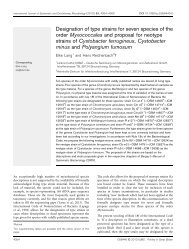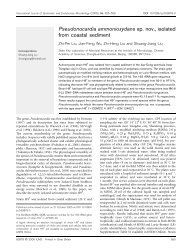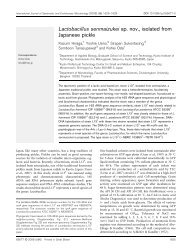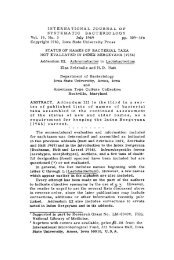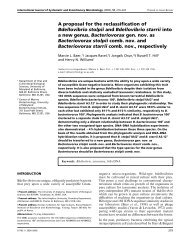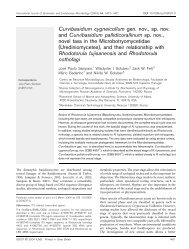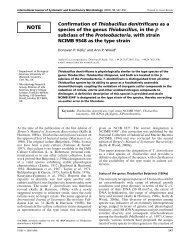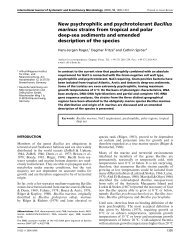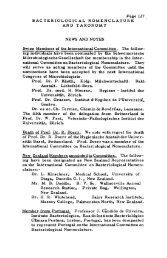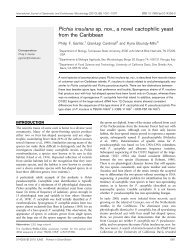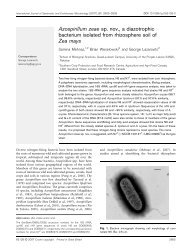Taxonomic Study of Bacillus coagulans Hammer 1915 with a ...
Taxonomic Study of Bacillus coagulans Hammer 1915 with a ...
Taxonomic Study of Bacillus coagulans Hammer 1915 with a ...
Create successful ePaper yourself
Turn your PDF publications into a flip-book with our unique Google optimized e-Paper software.
INTERNATIONAL JOURNAL OF SYSTEMATIC BACTERIOLOGY, Jan. 1988, p. 63-73<br />
0020-7713/88/010063-11$02.00/0<br />
Vol. 38, No. 1<br />
<strong>Taxonomic</strong> <strong>Study</strong> <strong>of</strong> <strong>Bacillus</strong> <strong>coagulans</strong> <strong>Hammer</strong> <strong>1915</strong> <strong>with</strong> a<br />
Proposal for <strong>Bacillus</strong> srnithii sp. nov.<br />
LAWRENCE K. NAKAMURA,’* INGE BLUMENSTOCK,2 AND DIETER CLAUS2<br />
Northern Regional Research Center, Agricultural Research Service, U.S. Department <strong>of</strong> Agriculture, Peoria, Illinois<br />
61 604,’ and Deutsche Sammlung von Mikroorganismen, 3400 Gottingen, Federal Republic <strong>of</strong> Germany2<br />
Guanine-plus-cytosine (G + C) content determinations, deoxyribonucleic acid (DNA) relatedness estimations,<br />
and phenotypic similarity analyses <strong>of</strong> 90 strains identified previously as <strong>Bacillus</strong> <strong>coagulans</strong> <strong>Hammer</strong> <strong>1915</strong><br />
revealed that 52 (group 1) strains were <strong>Bacillus</strong> <strong>coagulans</strong> sensu stricto; 30 <strong>of</strong> the remaining organisms<br />
segregated into two distinct DNA relatedness groups, one consisting <strong>of</strong> 26 (group 2) strains and the other <strong>of</strong> 4<br />
(group 4) organisms. Five (group 3) strains were <strong>Bacillus</strong> licheniformis, and three (group 5) strains were B.<br />
stearothermophilus. Because group 2 was a major cluster <strong>of</strong> strains which did not correspond in their<br />
characteristics to any previously known group, efforts were made to determine its taxonomic position. Group<br />
2, <strong>with</strong> G+C contents ranging from 37 to 40 mol%, was compared <strong>with</strong> other species generally characterized<br />
as having G+C contents ranging from 37 to 44 mol% or capable <strong>of</strong> growing at 50°C or both (namely, <strong>Bacillus</strong><br />
alcalophilus, <strong>Bacillus</strong> azot<strong>of</strong>ormans, <strong>Bacillus</strong> badius, <strong>Bacillus</strong> firmus, <strong>Bacillus</strong> globiformis, <strong>Bacillus</strong> laterosporus,<br />
<strong>Bacillus</strong> macquariensis, <strong>Bacillus</strong> marinus, <strong>Bacillus</strong> megaterium, <strong>Bacillus</strong> pumilus, and <strong>Bacillus</strong> subtilis). Low<br />
DNA relatedness values and poor matching <strong>of</strong> phenotypic characteristics strongly indicated that group 2<br />
organisms are strains <strong>of</strong> a new species, for which the name <strong>Bacillus</strong> smithii is proposed. The type strain <strong>of</strong> the<br />
new species is strain NRRL NRS-173.<br />
<strong>Bacillus</strong> <strong>coagulans</strong> is an economically important species<br />
because it is frequently involved in the coagulation <strong>of</strong> canned<br />
milk and flat-souring <strong>of</strong> other carbohydrate-containing<br />
canned foods (17). The production <strong>of</strong> high concentrations <strong>of</strong><br />
L-(+)-lactic acid causes the spoilage (40). <strong>Hammer</strong> first<br />
isolated this thermoduric organism from spoiled canned milk<br />
and described it as a new species in <strong>1915</strong> (22). In ensuing<br />
studies, morphological and physiological inconsistencies exhibited<br />
by the species have perplexed taxonomists. For<br />
example, Smith et al. (49, Bradley and Franklin (3, and<br />
Seki et al. (43) observed that the morphologies <strong>of</strong> the cells,<br />
spore surfaces, and sporangia could vary from strain to<br />
strain. Based on similarity analyses <strong>of</strong> API tests, Logan and<br />
Berkeley (26) noted that many B. <strong>coagulans</strong> strains clustered<br />
outside the B. <strong>coagulans</strong> phenon. Wolf and Barker (51) and<br />
Klaush<strong>of</strong>er and Hollaus (23) identified two types based on<br />
differences in maximum growth temperatures and in some<br />
physiological and biochemical characteristics, such as<br />
growth at pH 4.5 and 7.7, growth at 60”C, production <strong>of</strong><br />
acetylmethylcarbinol, coagulation <strong>of</strong> litmus milk, and fermentation<br />
<strong>of</strong> arabinose, mannitol, starch, and sucrose. In<br />
contrast, strains studied by Gordon and Smith (19) did not<br />
separate so neatly into two distinct groups. Moreover, Priest<br />
et al. (38) demonstrated an overall homogeneity <strong>of</strong> B. <strong>coagulans</strong><br />
by performing a numerical analysis <strong>of</strong> data published<br />
by Gordon et al. (18). The high variability has undoubtedly<br />
encouraged the creation <strong>of</strong> subjective synonyms, such as<br />
“<strong>Bacillus</strong> thermoacidurans” (3), “<strong>Bacillus</strong> dextrolacticus’ ’<br />
(l), “<strong>Bacillus</strong> thermoacidificans” (39), and “Lactobacillus<br />
cereale” (35).<br />
The reported wide range <strong>of</strong> 41 to 55 mol% for the guanineplus-cytosine<br />
(G+C) contents <strong>of</strong> deoxyribonucleic acids<br />
(DNAs) (6, 30, 37) indicated genetic heterogeneity in B.<br />
<strong>coagulans</strong>. Blumenstock (Ph.D. thesis, University <strong>of</strong> Gottingen,<br />
Gottingen, Federal Republic <strong>of</strong> Germany, 1984)<br />
* Corresponding author.<br />
found two groups <strong>of</strong> B. <strong>coagulans</strong> strains <strong>with</strong> different<br />
phenotypic and genotypic characteristsics. Finding the level<br />
<strong>of</strong> DNA relatedness among B. <strong>coagulans</strong> strains to be high,<br />
other workers considered the species to be genetically<br />
homogeneous (37,43). The genetic homogeneity and phenotypic<br />
homogeneity reported by some workers probably<br />
reflect the fortuitous selection <strong>of</strong> strains which happen to be<br />
closely related.<br />
The variability <strong>of</strong> B. <strong>coagulans</strong> appears in part to be a true<br />
characteristic <strong>of</strong> the species; also, it probably reflects the<br />
genetic heterogeneity <strong>of</strong> the taxon. To determine the degree<br />
to which the phenotypic heterogeneity could be attributed to<br />
genetic heterogeneity and to phenotypic variation, in this<br />
study we assessed the extent <strong>of</strong> genetic homogeneity <strong>of</strong> the<br />
species by measuring G+C contents and levels <strong>of</strong> DNA<br />
relatedness.<br />
MATERIALS AND METHODS<br />
Bacterials strains. The B. <strong>coagulans</strong> strains used in this<br />
study are listed in Table 1. Also used in this study were<br />
<strong>Bacillus</strong> alcalophilus Vedder 1934 NRRL B-14309T (= DSM<br />
4MT) (T = type strain), <strong>Bacillus</strong> alvei Cheshire and Cheyne<br />
1885 NRRL B-383T (= DSM 29T), <strong>Bacillus</strong> azot<strong>of</strong>ormans<br />
Pichinoty, de Barjac, Mandel, and Asselineau 1983 NRRL<br />
B-14310T (= DSM 1046T), <strong>Bacillus</strong> badius Batchelor 1919<br />
NRRL NRS-663T (= DSM 23T), <strong>Bacillus</strong> brevis Migula 1900<br />
NRRL NRS-604T (= DSM 30T), <strong>Bacillus</strong> Jirmus Bredemann<br />
and Werner 1933 NRRL B-14307T (= DSM 12T), <strong>Bacillus</strong><br />
globisporus Larkin and Stokes 1967 NRRL B-3396T (= DSM<br />
4T), <strong>Bacillus</strong> laterosporus Laubach 1916b NRRL NRS-314T<br />
(= DSM 25T), <strong>Bacillus</strong> licheniformis (Weigmann) Chester<br />
1901 NRRL NRS-1264T (= DSM 13T), <strong>Bacillus</strong> macquariensis<br />
Marshall and Ohye 1966 NRRL B-14306T (= DSM<br />
2T), <strong>Bacillus</strong> marinus (Ruger and Richter 1979) Ruger 1983<br />
NRRL B-14321T (= DSM 1297T), <strong>Bacillus</strong> megaterium de<br />
Bary 1884 NRRL B-1430gT (= DSM 32T), <strong>Bacillus</strong> polymyxa<br />
(Prazmowski) Mace 1889 NRRL NRS-llOST (= DSM 36T),<br />
63
64 NAKAMURA ET AL. INT. J. SYST. BACTERIOL.<br />
TABLE 1. List <strong>of</strong> B. <strong>coagulans</strong> strains used in this study<br />
Laboratory no. Received as strain: Source“ Strain historyb<br />
IVRRL B-768<br />
NRRL B-1103<br />
NRRL B-1167<br />
NRRL B-1168<br />
IVRRL B-1175<br />
IVRRL B-1178<br />
IVRRL B-1179<br />
IVRRL B-1180<br />
IVRRL B-1181<br />
IVRRL B-4284<br />
NRRL B-14027<br />
IVRRL B-14311<br />
NRRL B-14312<br />
IVRRL B-14313<br />
IVRRL B-14314<br />
lVRRL B-14315<br />
IVRRL B-14316<br />
YRRL B-14317<br />
NRRL B-14318<br />
NRRL NRS-54 to -58<br />
IVRRL NRS-83<br />
IVRRL NRS-96 to -105<br />
IVRRL NRS-114, -115,<br />
-121, -126, -134, -138 to<br />
-140, -142 to -145<br />
:VRRL NRS-169 to -176<br />
IVRRL NRS-177 to -184<br />
NRRL NRS-185<br />
NRRL NRS-186<br />
IVRRL NRS-190a1 -191 ,<br />
-192a<br />
IVRRL NRS-198, -200<br />
IVRRL NRS-609T<br />
IVRRL NRS-770<br />
NRRL NRS-795 to -797<br />
NRRL NRS-798<br />
IVRRL NRS-905<br />
IVRRL NRS-1371, -1375,<br />
-1376<br />
IVRRL NRS-2006 to -2008<br />
IVRRL NRS-2011<br />
IVRRL NRS-2012<br />
I’JRRL NRS-2013<br />
NRRL NRS-2016<br />
NRRL NRS-2020<br />
IVRRL NRS-2021 to -2023<br />
NRS-784<br />
ATCC 8038<br />
NRS-13<br />
NRS-14<br />
NRS-21<br />
NRS-24<br />
NRS-25<br />
NRS-26<br />
NRS-27<br />
8173<br />
212<br />
DSM 459<br />
DSM 460<br />
DSM 2319<br />
DSM 2320<br />
DSM 2321<br />
DSM 2313<br />
DSM 2357<br />
DSM 2358<br />
NRS-54 to -58<br />
NRS-83<br />
NRS-96 to -105<br />
NRS-114, -115, -121,<br />
-126, -134, -138 to<br />
-140, -142 to -145<br />
NRS-169 to -176<br />
NRS-177 to -184<br />
NRS-185<br />
NRS-186<br />
NRS-190 to -192<br />
NRS-198, -200<br />
NRS-609T<br />
NRS-770<br />
NRS-795 to -797<br />
NRS-798<br />
NRS-905<br />
NRS-1371, -1375,<br />
-1376<br />
NRS-2006 to -2008<br />
NRS-2011<br />
NRS-2012<br />
NRS-2013<br />
NRS-2016<br />
NRS-2020<br />
NRS-2021 to -2023<br />
1<br />
2<br />
1<br />
1<br />
1<br />
1<br />
1<br />
1<br />
1<br />
3<br />
3<br />
4<br />
4<br />
4<br />
4<br />
4<br />
4<br />
4<br />
4<br />
5<br />
5<br />
5<br />
5<br />
5<br />
5<br />
5<br />
5<br />
5<br />
5<br />
5<br />
5<br />
5<br />
5<br />
5<br />
5<br />
5<br />
5<br />
5<br />
5<br />
5<br />
5<br />
5<br />
C. H. Werkman, “<strong>Bacillus</strong> dextrolacticus”; (DSM 2311)“<br />
NCA 43P, “B. therrnoacidurans”<br />
H. C. Curran 195<br />
H. C. Curran 1460<br />
R. W. Pilcher 94S, “B. therrnoacidurans”<br />
R. W. Pilcher 4E, “B. thermoacidurans”<br />
R. W. Pilcher 6, “B. therrnoacidurans”<br />
R. W. Pilcher 43P, “B. thermoacidurans”<br />
R. W. Pilcher 78G, “B. therrnoacidurans”; (DSM 2383)<br />
From raw buffalo milk<br />
From raw buffalo milk<br />
F. Hollaus E28-66, from sugar beet juice<br />
F. Hollaus E3O-66, from sugar beet juice<br />
F. Hollaus E35-66, from sugar beet juice<br />
F. Hollaus E45-66, from sugar beet juice<br />
F. Hollaus E50-67, from sugar beet juice<br />
NCIB 10278 from R.S.C. Aytoun 186<br />
NCIB 10279 from R.S.C. Aytoun a-1<br />
NCIB 10280 from R.S.C. Aytoun a-7<br />
NCA 4167, NCA F43, NCA 52-240, NCA 4578, NCA 4110<br />
E. McCoy, Pan strains E<br />
N. R. Smith, from cream<br />
NCA 1215, NCA 1264, NCA 1460, NCA 1734, NCA 848, NCA<br />
518, NCA 698, NCA 880, NCA 1500, NCA 11878, NCA 2,<br />
NCA 4<br />
N. R. Smith, from cheese<br />
N. R. Smith, from alfalfa silage<br />
E. J. Hehre N9<br />
P. Renco, “B. therrnoacidurans”<br />
N. R. Smith, from cheese<br />
NCA C-1655, NCA (2-2291, NCA (2-1657<br />
J. R. Porter from B. W. <strong>Hammer</strong>; (DSM lT, ATCC 7050T); type<br />
strain<br />
NCA, “B. therrnoacidurans”<br />
B. W. <strong>Hammer</strong> 195, 196, 198, from canned evaporated milk<br />
B. W. <strong>Hammer</strong> 200; from canned evaporated milk; (DSM 2356)<br />
J. R. Porter from M. Schieblich, “<strong>Bacillus</strong> modestus” M21<br />
W. G. Walters 71, 5-2, 5-3; from hot spring<br />
R. F. Brooks, “<strong>Bacillus</strong> calidolactis”<br />
E. Olsen, “B. therrnoacidurans ,” from sugar-refining laboratory<br />
E. Olsen, “L. cereale” U, from sugar-refining laboratory; (DSM<br />
2350)<br />
E. Olsen, “L. cereale” B, from sugar-refining laboratory<br />
C. S. Pederson, from spoiled canned tomatoes<br />
C. S. Pederson, Lactobacillus delbrueckii 1260<br />
NCA 3991, NCA 1035, NCA 1036; “B. therrnoacidurans”<br />
‘’ 1, N. R. Smith, U.S. Department <strong>of</strong> Agriculture Research Center, Beltsville, Md.; 2, American Type Culture Collection, Rockville, Md; 3, M. N. Magdoub,<br />
Ain Shamo University, Cairo, Egypt; 4, Deutsche Sammlung von Mikroorganismen, Gottingen, Federal Republic <strong>of</strong> Germany; 5, the N. R. Smith <strong>Bacillus</strong><br />
collection maintained by R. E. Gordon, Rutgers University, New Brunswick, N.J.<br />
NCA, National Canners Association, San Francisco, Calif.<br />
Names in quotation marks are not on the Approved Lists <strong>of</strong> Bacterial Names (44) and have not been validly published since January 1980. Designations in<br />
parentheses are equivalent strain numbers.<br />
13acillus pumilus Meyer and Gottheil 1901 NRRL NRS-272T<br />
(= DSM 27T), <strong>Bacillus</strong> stearothermophilus Donk 1920 NRRL<br />
13-1172T (= DSM 22T), and <strong>Bacillus</strong> subtilis (Ehrenberg 1835)<br />
Cohn 1872 NRRL NRS-744T (= DSM loT). These strains are<br />
maintained by the Agricultural Research Service Culture Col-<br />
1,ection (NRRL) at the Northern Regional Research Center,<br />
Peoria, Ill., and by the Deutsche Sammlung von Mikroorganismen<br />
(DSM), Gottingen, Federal Republic <strong>of</strong> Germany. The<br />
NRRL strain designations include the prefixes B- and NRS-;<br />
the prefix B- denotes strains that were obtained directly from a<br />
source or strains that were isolated at the Northern Regional<br />
Research Center, and the prefix NRS- designates strains <strong>of</strong> the<br />
<strong>Bacillus</strong> collection <strong>of</strong> N. R. Smith, which has been deposited in<br />
toto at the Northern Regional Research Center by R. E.<br />
Gordon.<br />
For maintenance all strains were grown on nutrient agar<br />
containing 5 mg <strong>of</strong> MnSO, per liter or soil extract agar (18)<br />
until spores were formed. B. <strong>coagulans</strong> was grown at 45”C,<br />
B. stearothermophilus was grown at 50”C, B. globisporus, B.<br />
macquariensis, and B. marinus were grown at 25”C, and all<br />
other strains were grown at 30°C. The cultures were stored<br />
at 4°C and were transferred semiannually.<br />
DNA investigations. The cells were grown in nutrient broth<br />
under agitation and were harvested by centrifugation in the
VOL. 38, 1988 BACILLUS SMITHII SP. NOV. 65<br />
late logarithmic growth phase. Previous publications have<br />
described the procedure for preparing highly purified DNA<br />
samples by hydroxyapatite chromatography (34) and the<br />
methods used for estimating the extent <strong>of</strong> DNA reassociation<br />
by spectrophotometric determination <strong>of</strong> renaturation<br />
rates <strong>with</strong> a Gilford model 2600 ultraviolet spectrophotometer<br />
equipped <strong>with</strong> a model 2527 thermoprogrammer (8, 34).<br />
DNA relatedness values were calculated by using the equation<br />
<strong>of</strong> De Ley (14).<br />
The buoyant densities <strong>of</strong> DNA samples were measured by<br />
CsCl density gradient centrifugation in a Beckman model E<br />
ultracentrifuge to determine G+C contents (42). Micrococcus<br />
luteus (synonym, “Micrococcus lysodeikticus”)<br />
DNA <strong>with</strong> a buoyant density <strong>of</strong> 1.724 g/cm’ (49), which was<br />
purchased from Sigma Chemical Co., St. Louis, Mo., served<br />
as an internal standard.<br />
The G+C contents <strong>of</strong> strains NRRL B-14311, NRRL<br />
B-14312, NRRL B-14313, NRRL B-14314, NRRL B-14315,<br />
NRRL B-14316, NRRL B-14317, and NRRL B-14318 were<br />
calculated from the thermal melting point (T,) by using the<br />
following equation: G+C content = 2.44 x (T, - 69.4) (13).<br />
All values were corrected for the differences between the<br />
determined G +C content <strong>of</strong> the reference Escherichia coli<br />
DNA (Sigma) and 50.9 mol%, the value used by De Ley for<br />
E. coli. A detailed description <strong>of</strong> the method has been given<br />
by Mandel and Marmur (28) and Fahmy et al. (16). The<br />
DNAs used for these determinations were purified by a<br />
modification <strong>of</strong> the method <strong>of</strong> Marmur (16, 29).<br />
Characterization. Morphological properties were examined<br />
by phase-contrast microscopy, using slides coated <strong>with</strong><br />
a thin layer (1 mm) <strong>of</strong> purified agar (catalog no. 1613; Merck<br />
& Co., Inc., Rahway, N.J.). The sizes <strong>of</strong> cells were calculated<br />
from photomicrographs (Photomicroscope 11; Zeiss).<br />
The mode <strong>of</strong> flagellation was examined by using the staining<br />
method described by Mayfield and Inniss (31) or Kodaka et<br />
al. (24). To determine the Gram reaction, we used the<br />
method <strong>of</strong> Bartholomew (2), <strong>with</strong> n-propanol as the decolorizing<br />
agent. The Gram reaction was compared <strong>with</strong> lysis <strong>of</strong><br />
cells by 3% (wthol) KOH (20) and the Cerny aminopeptidase<br />
test (7). The maximum growth temperature was tested<br />
in a thermostatically controlled water bath in 5°C intervals.<br />
The cultures were inoculated onto nutrient agar slants.<br />
Unless stated otherwise, the methods <strong>of</strong> Gordon et al. (18)<br />
were used to characterize the strains. The carbohydrate<br />
fermentation tests were conducted in broth and not on agar<br />
slants, To a basal medium modified to contain (per liter) 1 g<br />
<strong>of</strong> (NH,),HPO,, 0.7 g <strong>of</strong> yeast extract, 0.2 g <strong>of</strong> KCl, 0.2 g <strong>of</strong><br />
MgSO, . 7H,O, and 15 ml <strong>of</strong> a 0.04% solution <strong>of</strong> bromcresol<br />
purple was added a separately sterilized solution <strong>of</strong> one <strong>of</strong><br />
the following sugars to a final concentration <strong>of</strong> 1%: L-<br />
arabinose, D-fructose, D-galactose, D-glucose, lactose, maltose,<br />
D-mannitol, D-mannose, melibiose, L-rhamnose, D-<br />
ribose, salicin, D-sorbitol, sucrose, trehalose, and D-xylose.<br />
The organic acid utilization tests included acetate, fumarate,<br />
malate, and succinate tests in addition to citrate and propionate<br />
tests. For these utilization tests, the basal medium was<br />
modified to contain (per liter) 0.5 g <strong>of</strong> yeast extract, 0.4 g <strong>of</strong><br />
MgSO,. 7H,O, and 0.03 g <strong>of</strong> bromthymol blue. Medium<br />
containing no organic acids was used as a control. Arginine,<br />
lysine, and ornithine decomposition was determined in<br />
Moeller decarboxylase broth (32). Hydrogen sulfide production<br />
was detected by stab culturing in triple sugar iron agar<br />
(21). Urease activity was determined by the method <strong>of</strong><br />
Edwards and Ewing (15). Acetylmethylcarbinol was detected<br />
<strong>with</strong> reagents described by Coblentz (9). Hydrolysis<br />
<strong>of</strong> pullulan was determined by the methods <strong>of</strong> Morgan et al.<br />
(33). The oxidase reaction and hydrolysis <strong>of</strong> chitin and DNA<br />
were determined by the method <strong>of</strong> Cowan (11). Diaminopimelic<br />
acid in the vegetative cell walls was determined<br />
qualitatively by the thin-layer chromatographic method <strong>of</strong><br />
Kutzner (25). The qualitative menaquinone contents <strong>of</strong> vegetative<br />
cells were determined by the method <strong>of</strong> Collins et al.<br />
(10).<br />
In addition to the standard methods used in <strong>Bacillus</strong><br />
diagnostics, the API 20E and API 5OCHB test systems were<br />
used according to the instructions <strong>of</strong> the manufacturer.<br />
Numerical analyses. The organisms were screened for 49<br />
differential characteristics, and positive and negative results<br />
were coded as 1 and 0, respectively. Similarity among strains<br />
was estimated by means <strong>of</strong> the simple matching coefficient,<br />
and clustering was based on the unweighted pair group<br />
arithmetic average algorithm (46, 47). Computations were<br />
carried out <strong>with</strong> an IBM PC computer by using the TAXO-<br />
NOPC program <strong>of</strong> D. Labeda (Northern Regional Research<br />
Center).<br />
RESULTS<br />
Based on the analyses <strong>of</strong> G+C contents shown in Table 2,<br />
the 90 B. <strong>coagulans</strong> strains separated into three clusters. The<br />
57 strains in the largest cluster (groups 1 and 3) had G+C<br />
contents ranging from 45 to 47 mol%, a range that included<br />
the base content (45 mol%) <strong>of</strong> type strain NRRL NRS-609.<br />
Of the 33 remaining organisms, 30 had G+C contents which<br />
ranged from 37 to 40 mol% (groups 2 and 4), and 3 had G+C<br />
contents which ranged from 52 to 53 mol% (group 5).<br />
As indicated by the data in Table 2, the strains studied<br />
could also be separated in five distinct DNA relatedness<br />
groups. Group 1 included 52 strains <strong>with</strong> G+C contents<br />
ranging from 45 to 47 mol%, and these strains gave high<br />
DNA complementarity values <strong>of</strong> 76 to 100% <strong>with</strong> B. coaguluns<br />
type strain NRRL NRS-609 (= DSM 1). As shown in<br />
Table 3, DNA relatedness values <strong>of</strong> 16 to 34% were measured<br />
between the group l reference strain and the following<br />
strains <strong>of</strong> currently recognized species: B. alvei NRRL<br />
B-383T, B. badius NRRL NRS-633T, B. brevis NRRL NRS-<br />
604T, B. licheniformis NRRL NRS-1264T, B. macerans<br />
NRRL B-4267T, B. polymyxa NRRL NRS-llOST, B. stearothermophilus<br />
NRRL B-1172T, and B. subtilis NRRL NRS-<br />
744T. These currently recognized species were selected<br />
because they grow at 50 to 60°C or have G+C contents <strong>of</strong> 43<br />
to 52 mol% or both.<br />
Group 3 organisms had G+C contents <strong>of</strong> 45 to 46 mol%.<br />
However, low DNA reassociation values <strong>of</strong> 18 to 31%<br />
measured <strong>with</strong> the group 1 reference strain indicated that the<br />
group 3 organisms were not closely related genetically to<br />
group 1 (Table 2). Group 3 consisted <strong>of</strong> reference strain<br />
NRRL B-4284 and four other strains <strong>with</strong> which high DNA<br />
relatedness values (99 to 100%) were obtained. B. licheniformis<br />
NRRL NRS-1264T and reference strain NRRL B-<br />
4284 were closely related genetically, as suggested by the<br />
100% relatedness <strong>of</strong> their DNAs (Table 3). High DNA<br />
relatedness values <strong>of</strong> 95 to 100% (data not shown) were also<br />
observed between strain NRRL NRS-1264T and other group<br />
3 strains.<br />
Included in groups 2 and 4 were strains <strong>with</strong> G+C contents<br />
<strong>of</strong> 37 to 40 mol% (Table 2). Although selected strains<br />
yielded low DNA complementarity values <strong>of</strong> 14 to 37% <strong>with</strong><br />
group 1, 3, 4, and 5 reference strains, group 2 strains (26<br />
strains) gave high DNA relatedness values <strong>of</strong> 78 to 100%<br />
<strong>with</strong> reference strain NRRL NRS-173. Group 4 consisted <strong>of</strong><br />
reference strain NRRL NRS-139 and three genetically
-<br />
NRRL strain no.<br />
-<br />
Group 1<br />
B-768<br />
B-1103<br />
B-1167<br />
B-1168<br />
B-1178<br />
B-1179<br />
B-1180<br />
B-1181<br />
NRS-54<br />
NRS-55<br />
NRS-56<br />
NRS-57<br />
NRS-58<br />
NRS-83<br />
NRS-105<br />
NRS-114<br />
NRS-115<br />
NRS-121<br />
NRS-126<br />
NRS-134<br />
NRS-144<br />
NRS-145<br />
NRS-171<br />
NRS-172<br />
NRS-175<br />
NRS-176<br />
NRS-177<br />
NRS-178<br />
NRS-181<br />
NRS-182<br />
NRS-183<br />
NRS-184<br />
NRS-186<br />
NRS- 190a<br />
NRS-191<br />
NRS-192a<br />
NRS-198<br />
NRS-609T<br />
NRS-770<br />
N R S -795<br />
NRS-796<br />
NRS-797<br />
NRS-798<br />
NRS-2007<br />
NRS-2011<br />
NRS-2012<br />
NRS-2013<br />
NRS-2016<br />
NRS-2020<br />
NRS-2021<br />
NRS-2022<br />
NRS-2023<br />
Group 2<br />
B-1175<br />
B-14311<br />
B-14312<br />
B-14313<br />
B-14314<br />
B- 14315<br />
NRS-96<br />
NRS-97<br />
NRS-98<br />
NRS-99<br />
NRS-100<br />
NRS-101<br />
NRS-102<br />
NRS-103<br />
NRS-104<br />
NRS-138<br />
-<br />
TABLE 2. DNA relatedness <strong>of</strong> B. <strong>coagulans</strong> strains<br />
G+C content<br />
% Reassociation <strong>with</strong> DNA from strainf<br />
(mol%) NRRL NRS-6WT NRRL NRS-173 NRRL B-4284 NRRL NRS-139 NRRL B-14317<br />
45<br />
45<br />
45<br />
45<br />
45<br />
45<br />
45<br />
45<br />
45<br />
45<br />
46<br />
45<br />
46<br />
46<br />
45<br />
41<br />
45<br />
45<br />
45<br />
45<br />
45<br />
46<br />
46<br />
45<br />
45<br />
45<br />
47<br />
45<br />
45<br />
45<br />
46<br />
46<br />
45<br />
47<br />
45<br />
45<br />
45<br />
45<br />
45<br />
45<br />
45<br />
46<br />
45<br />
45<br />
45<br />
45<br />
45<br />
45<br />
46<br />
45<br />
45<br />
46<br />
40<br />
39<br />
40<br />
39<br />
40<br />
39<br />
40<br />
40<br />
40<br />
39<br />
39<br />
39<br />
39<br />
40<br />
40<br />
40<br />
98<br />
96<br />
92<br />
93<br />
91<br />
87<br />
100<br />
93<br />
91<br />
100<br />
95<br />
94<br />
97<br />
82<br />
92<br />
100<br />
87<br />
94<br />
100<br />
95<br />
95<br />
88<br />
80<br />
85<br />
80<br />
88<br />
91<br />
83<br />
76<br />
80<br />
100<br />
95<br />
90<br />
85<br />
96<br />
91<br />
100<br />
80<br />
100<br />
100<br />
82<br />
95<br />
100<br />
87<br />
95<br />
100<br />
80<br />
78<br />
100<br />
99<br />
100<br />
23<br />
32<br />
31<br />
30<br />
29<br />
32<br />
14<br />
28<br />
23<br />
25<br />
23<br />
33<br />
33<br />
34<br />
35<br />
20<br />
31<br />
28<br />
33<br />
29<br />
30<br />
30<br />
33<br />
28<br />
27<br />
30<br />
29<br />
33<br />
100<br />
87<br />
95<br />
89<br />
90<br />
98<br />
100<br />
100<br />
94<br />
99<br />
99<br />
96<br />
86<br />
100<br />
87<br />
98<br />
28<br />
34<br />
29<br />
36<br />
27<br />
27<br />
27<br />
29<br />
27<br />
30<br />
21<br />
21<br />
22<br />
25<br />
33<br />
29<br />
33<br />
32<br />
35<br />
29<br />
34<br />
28<br />
34<br />
30<br />
34<br />
30<br />
29<br />
28<br />
38<br />
37<br />
27<br />
37<br />
39<br />
28<br />
39<br />
33<br />
30<br />
32<br />
26<br />
32<br />
28<br />
24<br />
29<br />
29<br />
29<br />
37<br />
Continued on following page
VOL. 38, 1988 BACILLUS SMITHII SP. NOV. 67<br />
TAB L E 2-Con<br />
tin u e d<br />
NRRL strain no.<br />
NRS-140<br />
NRS-142<br />
NRS-143<br />
NRS-169<br />
NRS-170<br />
NRS-173'<br />
NRS-174<br />
NRS-199<br />
NRS-1371<br />
NRS-2008<br />
Group 3<br />
B-4284'<br />
B-14027<br />
NRS-185<br />
NRS-1375<br />
NRS-1376<br />
Group 4<br />
NRS-139'<br />
NRS-200<br />
NRS-905<br />
NRS-2006<br />
Group 5<br />
B-14316<br />
B-14317'<br />
B-14318<br />
G+C content<br />
(mol%)<br />
40<br />
40<br />
39<br />
40<br />
40<br />
40<br />
40<br />
38<br />
40<br />
39<br />
46<br />
46<br />
45<br />
46<br />
45<br />
38<br />
37<br />
37<br />
37<br />
52<br />
52<br />
53<br />
% Reassociation <strong>with</strong> DNA from strainf<br />
NRRL NRS-609~r NRRL NRS-173 NRRL B-4284 NRRL NRS-139 NRRL B-14317<br />
35<br />
34<br />
29<br />
34<br />
31<br />
30<br />
26<br />
29<br />
32<br />
29<br />
18<br />
23<br />
30<br />
30<br />
31<br />
26<br />
38<br />
32<br />
29<br />
33<br />
31<br />
29<br />
100<br />
94<br />
99<br />
98<br />
97<br />
(100)<br />
100<br />
78<br />
100<br />
100<br />
22<br />
10<br />
18<br />
20<br />
13<br />
20<br />
24<br />
23<br />
27<br />
33<br />
35<br />
34<br />
20<br />
23<br />
20<br />
25<br />
24<br />
22<br />
(100)<br />
100<br />
99<br />
100<br />
100<br />
13<br />
15<br />
25<br />
18<br />
29<br />
30<br />
30<br />
28<br />
30<br />
22<br />
23<br />
22<br />
27<br />
23<br />
23<br />
36<br />
32<br />
27<br />
33<br />
34<br />
28<br />
36<br />
36<br />
29<br />
30<br />
29<br />
35<br />
38<br />
36<br />
35<br />
30<br />
29<br />
98<br />
(100)<br />
84<br />
Reassociation values are averages <strong>of</strong> two determinations; the maximum difference noted between determinations was 8%.<br />
Values in parentheses indicate that, by definition, the reassociation value was 100%.<br />
Reference strain for the group.<br />
closely related strains (DNA relatedness values, 99%). Low<br />
DNA relatedness values <strong>of</strong> 20 to 34% were measured between<br />
group 2 and 4 reference strains and the type strains <strong>of</strong><br />
the currently recognized species (Table 3).<br />
Group 5 included three strains that have G+C contents <strong>of</strong><br />
52 to 53 mol% and give high DNA complementarity values<br />
<strong>with</strong> reference strain NRRL B-14317. Low levels <strong>of</strong> DNA<br />
relatedness to their reference strains (27 to 36%) indicate<br />
that group 5 is not closely related genetically to group 1,2,3,<br />
or 4. The high level <strong>of</strong> DNA relatedness <strong>of</strong> B. stearothermo-<br />
philus NRRL B-1172T and NRRL B-14317 suggests that<br />
group 5 must be B. stearothermophilus (Table 3).<br />
Figure 1 is a dendrogram, based on phenotypic characters<br />
and plotted from computer-generated linkage data, that<br />
shows the clustering <strong>of</strong> strains by using a simple matching<br />
coefficient and an unweighted average-linkage algorithm. At<br />
a similarity level <strong>of</strong> 85%, the matrix formed five phena.<br />
Significantly, the strains found in any one <strong>of</strong> the phena were<br />
also the strains collected into groups on the basis <strong>of</strong> their<br />
high levels <strong>of</strong> DNA relatedness. For example, the strain<br />
TABLE 3. DNA relatedness <strong>of</strong> group reference strains and <strong>Bacillus</strong> type strains<br />
Strain<br />
B. aicalophilus NRRL B-14309T<br />
B. megateriurn NRRL B-14308T<br />
B. marinus NRRL B-14321<br />
B. azot<strong>of</strong>ormans NRRL B-14310T<br />
B. macquariensis NRRL B-14306T<br />
B. globisporus NRRL B-3396T<br />
B. laterosporus NRRL NRS-314T<br />
B. firmus NRRL B-14307T<br />
€3. pumilus NRRL NRS-272T<br />
B. subtilis NRRL NRS-744T<br />
B. badius NRRL NRS-663T<br />
B. polymyxa NRRL NRS-llOST<br />
B. alvei NRRL B-383T<br />
B. licheniformis NRRL NRS-1264T<br />
B. brevis NRRL NRS-604T<br />
B. stearothermophilus NRRL B-1172T<br />
B. rnacerans NRRL B-4267T<br />
G+C content<br />
% Reassociation <strong>with</strong> DNA from group reference strain:b<br />
(mol%'o)" NRRL NRS-609= NRRL NRS-173 NRRL B-4284 NRRL NRS-139 NRRL B-14317<br />
37.0<br />
37.1<br />
37.7<br />
39.0<br />
39.3<br />
39.7<br />
40.2<br />
41.5<br />
42.0<br />
42.9<br />
43.8<br />
44.5<br />
44.6<br />
46.3<br />
47.5<br />
51.9<br />
52.2<br />
23<br />
24<br />
32<br />
34<br />
29<br />
16<br />
28<br />
30<br />
33<br />
29<br />
23<br />
32<br />
29<br />
22<br />
23<br />
34<br />
30<br />
25<br />
21<br />
23<br />
21<br />
23<br />
20<br />
20<br />
25<br />
21<br />
24<br />
28<br />
20<br />
100<br />
22<br />
25<br />
29<br />
31<br />
24<br />
29<br />
27<br />
33<br />
33<br />
31<br />
85<br />
35<br />
a Data from reference 16.<br />
Reassociation values are averages <strong>of</strong> two determinations; the maximum difference noted between determinations was 6%.
68 NAKAMURA ET AL.<br />
5a<br />
70 80 90 100<br />
f I I I 1<br />
r<br />
-<br />
-<br />
c<br />
-<br />
--NRs-144<br />
-NRs-177<br />
xNRS-182<br />
NRS- 184<br />
- NRS-20 12<br />
B-1188<br />
NRS-121<br />
- NRS-183<br />
- NRS-181<br />
-NRS-lQl<br />
NRS-1QOa<br />
NRS-770<br />
NRS-PO 16<br />
B-1179<br />
NRss4<br />
NRS- 105<br />
~<br />
VOL. 38, 1988 BACILLUS SMITHII SP. NOV. 69<br />
Characteristics<br />
Anaerobic growth<br />
Growth at:<br />
pH 4.5 in nutrient broth<br />
pH 7.7 in nutrient broth<br />
pH 5.7 in Sabouraud broth<br />
Growth in:<br />
7% NaCl<br />
0.02% Sodium azide<br />
Growth at:<br />
25°C<br />
55°C<br />
60°C<br />
65°C<br />
70°C<br />
Nitrate reduction to nitrite<br />
Denitrification<br />
Acetylmethylcarbinol in Voges-Proskauer broth'<br />
Oxidase reaction<br />
Arginine dihydrolase<br />
Utilization <strong>of</strong><br />
Citrate<br />
Proprionate<br />
Hydrolysis <strong>of</strong><br />
Casein<br />
Gelatin<br />
Pullulan<br />
Starch<br />
Litmus milk:<br />
Coagulated<br />
Acidified<br />
Fermentation <strong>of</strong><br />
L- Arabinose<br />
Cellobiose<br />
D-Galactose<br />
Lactose<br />
Maltose<br />
D-Mannitol<br />
D-Mannose<br />
Melibiose<br />
L-Rhamnose<br />
D-Ribose<br />
Salicin<br />
D-Sorbitol<br />
Starch<br />
Sucrose<br />
D-Xvlose<br />
TABLE 4. Salient characteristics <strong>of</strong> the B. <strong>coagulans</strong> DNA relatedness groups<br />
Group 1 Group 2 Group 3 Group 4 Group 5<br />
(n = 52) (n = 26) (n = 5) (n = 4) (n = 3)<br />
100"<br />
100<br />
100<br />
100<br />
100<br />
100<br />
100<br />
100<br />
100<br />
0<br />
0<br />
25<br />
0<br />
100<br />
5<br />
0<br />
33<br />
0<br />
0<br />
0<br />
100<br />
100<br />
100<br />
100<br />
71<br />
77<br />
100<br />
100<br />
100<br />
64<br />
100<br />
100<br />
64<br />
67<br />
77<br />
52<br />
100<br />
100<br />
67<br />
100<br />
0<br />
0<br />
100<br />
0<br />
5<br />
100<br />
100<br />
100<br />
73<br />
0<br />
0<br />
0<br />
0<br />
100<br />
0<br />
96<br />
67<br />
0<br />
0<br />
5<br />
21 (w)<br />
a The values are percentages <strong>of</strong> strains showing positive reactions. w, Weak.<br />
The pH values in Voges-Proskauer broth were 4.0 to 4.4 (group l), 4.3 to 4.7 (group 2), 5.1 to 6.6 (group 3), 6.6 to 7.0 (group 4), and 4.2 to 5.8 (group 5).<br />
0<br />
0<br />
67<br />
0<br />
86<br />
0<br />
57<br />
86<br />
38<br />
10<br />
29<br />
90<br />
15<br />
38<br />
0<br />
10<br />
95<br />
100<br />
0<br />
100<br />
100<br />
100<br />
0<br />
100<br />
100<br />
0<br />
0<br />
0<br />
100<br />
0<br />
100<br />
0<br />
100<br />
100<br />
100<br />
100<br />
100<br />
100<br />
100<br />
0<br />
0<br />
100<br />
100<br />
60<br />
0<br />
100<br />
100<br />
100<br />
40<br />
60<br />
100<br />
100<br />
80<br />
100<br />
100<br />
100<br />
0<br />
0<br />
100<br />
100<br />
0<br />
0<br />
100<br />
0<br />
0<br />
0<br />
0<br />
0<br />
0<br />
0<br />
0<br />
0<br />
0<br />
0<br />
0<br />
0<br />
0<br />
0<br />
0<br />
0<br />
100<br />
75<br />
75<br />
0<br />
100<br />
100<br />
100<br />
0<br />
100<br />
75<br />
25<br />
50<br />
0<br />
50<br />
100<br />
0<br />
0<br />
100<br />
0<br />
0<br />
0<br />
0<br />
100<br />
100<br />
100<br />
100<br />
100<br />
100<br />
0<br />
0<br />
0<br />
0<br />
0<br />
100<br />
100<br />
100<br />
100<br />
0<br />
0<br />
100<br />
0<br />
100<br />
0<br />
67<br />
0<br />
100<br />
100<br />
0<br />
100<br />
100<br />
0<br />
100<br />
100<br />
100<br />
to 60°C or both (Table 2). The data suggest that groups 2 and<br />
4 may be strains <strong>of</strong> yet-unnamed species.<br />
The gathering <strong>of</strong> numerous strains <strong>of</strong> five separate species<br />
<strong>with</strong>in the B. <strong>coagulans</strong> sensu lato group partially accounts<br />
for the observation <strong>of</strong> variants or subgroups by some workers<br />
(18, 23,51). Some <strong>of</strong> the phenotypic differences reported<br />
by Wolf and Barker (51) are noted when two major clusters<br />
(groups 1 and 2) are compared (Table 4). For example, the<br />
data reveal that B. <strong>coagulans</strong> sensu strict0 strains (group 1)<br />
produce acetylmethylcarbinol; coagulate milk; are oxidase<br />
negative; hydrolyze starch and pullulan; frequently ferment<br />
cellobiose, lactose, and salicin; grow in the presence <strong>of</strong><br />
0.02% azide; and grow variably at 60°C and not at all at 65°C.<br />
Group 2 strains grow at 60°C and variably at 65"C, are<br />
oxidase positive, and are essentially negative for the other<br />
characteristics. The group 1 strains observed in this study<br />
are very similar to the type B organisms <strong>of</strong> Wolf and Barker<br />
(51), group 2 strains correspond to the type A strains, and<br />
groups 3 through 5 may be the same as the intermediate<br />
types.<br />
Although intermixing <strong>of</strong> species has made B. <strong>coagulans</strong><br />
sensu lato a phenotypically heterogeneous taxon, the separation<br />
<strong>of</strong> species circumscribed on the basis <strong>of</strong> DNA relatedness<br />
has not necessarily yielded phenotypically homogeneous<br />
groups. As shown in Table 4, the two major clusters,<br />
groups 1 and 2, give variable reactions for nitrate reduction,<br />
maximum growth temperature, and, especially, sugar fermentation<br />
tests.<br />
The strains studied by Gordon et al. (18) all produced<br />
acetylmethylcarbinol, grew in the presence <strong>of</strong> 0.02% azide,<br />
acidified litmus milk (one exception), and hydrolyzed starch.<br />
These workers appear to have fortuitously selected only<br />
group 1 organisms for their study. Even among those strains<br />
variable reactions were observed for the fermentation <strong>of</strong>
70 NAKAMURA ET AL. INT. J. SYST. BACTERIOL.<br />
TABLE 5. Characterization <strong>of</strong> group 1 and 2 strains <strong>with</strong> the API<br />
20E and API 50 CHB test systems<br />
Characteristic"<br />
API 20E tests<br />
ONPG<br />
ADH<br />
LDC<br />
ODC<br />
Citrate (Simmons)<br />
H2S<br />
Urease<br />
TDA<br />
Indole<br />
Voges-Proskauer<br />
Gelatin<br />
Nitrate<br />
API 5OCHB tests<br />
Glycerol<br />
Erythritol<br />
D- Arabinose<br />
L-Arabinose<br />
Ribose<br />
D-Xylose<br />
L-Xylose<br />
Adonitol<br />
P-Methylxyloside<br />
D-Galactose<br />
D-Glucose<br />
D-Fructose<br />
D-Mannose<br />
L-Sorbose<br />
Rhamnose<br />
Dulcitol<br />
Inositol<br />
Mannitol<br />
Sorbitol<br />
a-Methyl-D-mannoside<br />
a-Methyl-D-glucoside<br />
N- Acet y lglucosamine<br />
Am ygdalin<br />
Arbutin<br />
Esculin<br />
Salicin<br />
Cellobiose<br />
Maltose<br />
Lactose<br />
Melibiose<br />
Sucrose<br />
Trehalose<br />
Inulin<br />
Melezitose<br />
D-Raffinose<br />
Starch<br />
Glycogen<br />
Xylitol<br />
P-Gentiobiose<br />
D-Turanose<br />
D-Ly xose<br />
D-Tagatose<br />
D-Fucose<br />
L-Fucose<br />
D-Arabitol<br />
L-Arabitol<br />
Gluconate<br />
2-Ketogluconate<br />
5-Ketogluconate<br />
% <strong>of</strong> strains showing positive<br />
reaction<br />
Group 1 Group 2<br />
(n = 9) (n = 22)<br />
30<br />
0<br />
0<br />
0<br />
0<br />
0<br />
0<br />
0<br />
0<br />
100<br />
0<br />
0<br />
100<br />
11<br />
22<br />
11<br />
44<br />
33<br />
0<br />
0<br />
0<br />
100<br />
100<br />
100<br />
100<br />
0<br />
22<br />
0<br />
22<br />
0<br />
22<br />
0<br />
22<br />
100<br />
33<br />
33<br />
89<br />
44<br />
55<br />
100<br />
67<br />
100<br />
99<br />
100<br />
0<br />
0<br />
67<br />
78<br />
0<br />
0<br />
44<br />
33<br />
0<br />
0<br />
0<br />
0<br />
22<br />
0<br />
22<br />
0<br />
0<br />
0<br />
0<br />
0<br />
0<br />
0<br />
0<br />
0<br />
0<br />
0<br />
36<br />
0<br />
0<br />
64<br />
14<br />
0<br />
27<br />
77<br />
99<br />
0<br />
0<br />
0<br />
9<br />
100<br />
100<br />
27<br />
0<br />
18<br />
0<br />
9<br />
82<br />
18<br />
0<br />
5<br />
0<br />
0<br />
0<br />
63<br />
18<br />
5<br />
87<br />
0<br />
0<br />
5<br />
100<br />
0<br />
0<br />
0<br />
0<br />
9<br />
5<br />
0<br />
0<br />
0<br />
0<br />
0<br />
0<br />
0<br />
0<br />
0<br />
0<br />
0<br />
ONPG, o-Nitrophenyl-P-galactosidase; ADH, arginine dihydrolase;<br />
L.DC, lysine decarboxylase; ODC, ornithine decarboxylase; TDA, tryptophan<br />
deaminase.<br />
arabinose, mannitol, and xylose; for the utilization <strong>of</strong> citrate;<br />
for the reduction <strong>of</strong> nitrate to nitrite; and for the hydrolysis<br />
<strong>of</strong> casein. Thus, for both B. <strong>coagulans</strong> sensu strict0 and<br />
group 2 strains, certain characteristics are inherently variable.<br />
Because group 2 constitutes a major portion <strong>of</strong> the B.<br />
<strong>coagulans</strong> sensu lato group, efforts have been made to<br />
determine its taxonomic position. As shown in Table 3,<br />
group 2 is not closely related genetically to organisms that<br />
have G+C contents <strong>of</strong> 37 to 44 mol% or grow at 50°C or both<br />
(namely, B. alcalophilus, B. azot<strong>of</strong>ormans, B. badius, B.<br />
firmus, B. globisporus, B. laterosporus, B. macquariensis,<br />
B. marinus, B. megaterium, B. pumilus, and B. subtilis). In<br />
addition to their inability to grow at 6WC, these organisms<br />
are distinguishable from group 2 strains by the key characteristics<br />
listed in Table 6.<br />
Group 2 organisms are also phenotypically distinct from<br />
previously described thermophilic <strong>Bacillus</strong> spp. (Table 7). In<br />
contrast to group 2, the known thermophiles are generally<br />
strictly aerobic, have G+C contents ranging from 45 to 68<br />
mol%, and do not grow at 25°C. Furthermore, the lowering<br />
<strong>of</strong> the pH in Voges-Proskauer broth to 5.0 or less and<br />
hydrolysis <strong>of</strong> casein differentiate B. stearotherrnophilus,<br />
<strong>Bacillus</strong> thermoglucosidasius, and B. brevis from group 2. B.<br />
stearothermophilus and B. thermoglucosidasius are further<br />
distinguished by their inability to grow at pH 5.7 and their<br />
ability to hydrolyze gelatin. In contrast to group 2 strains,<br />
<strong>Bacillus</strong> schlegelii and <strong>Bacillus</strong> tusciae are facultatively<br />
chemolithoautotrophic and reduce nitrate to nitrite. The<br />
acidophilic nature <strong>of</strong> <strong>Bacillus</strong> acidocaldarius further differentiates<br />
it from the group 2 organisms.<br />
On the basis <strong>of</strong> the data, we consider group 2 organisms to<br />
be strains <strong>of</strong> a new species, for which we propose the name<br />
<strong>Bacillus</strong> smithii. A description <strong>of</strong> this species is given below.<br />
<strong>Bacillus</strong> smithii sp. nov. <strong>Bacillus</strong> smithii (smi'thi.i.L. gen.<br />
n. smithii named after Nathan R. Smith, the American<br />
bacteriologist who has made fundamental contributions to<br />
the taxonomy <strong>of</strong> <strong>Bacillus</strong>) vegetative cells are rods that<br />
measure 0.8 to 1.0 by 5.0 to 6.0 km and are motile by<br />
peritrichous flagellation. Oval or cylindrical endospores (0.6<br />
TABLE 6. Key characteristics that differentiate currently<br />
recognized <strong>Bacillus</strong> spp. from group 2<br />
Species Key characteristic(s) Reference<br />
B. alcalophilus<br />
B. azot<strong>of</strong>ormans<br />
B. badius<br />
B. Jirmus<br />
B. globisporus<br />
B. laterosporus<br />
B. rnacquariensis<br />
B. marinus<br />
B. megaterium<br />
B. pumilus<br />
B. subtilis<br />
Grows at pH 10<br />
Produces N2 from nitrate<br />
Does not ferment glucose<br />
Does not grow anaerobically or at<br />
50°C<br />
Forms round spores; low optimum<br />
growth temperature <strong>of</strong> 20°C<br />
Unusual spore morphology; does<br />
not grow at pH 5.7<br />
Low optimum growth temperature<br />
<strong>of</strong> 20°C<br />
Low optimum growth temperature<br />
<strong>of</strong> 20°C<br />
Does not grow anaerobically or at<br />
50°C large cells<br />
Does not grow anaerobically or at<br />
60°C; produces acetylmethylcarbinol<br />
Does not grow anaerobically or at<br />
60°C; produces acetylmethylcarbinol<br />
50<br />
36<br />
18<br />
18<br />
18<br />
18<br />
18<br />
18<br />
18<br />
18<br />
18
VOL. 38, 1988 BACILLUS SMITH11 SP. NOV. 71<br />
TABLE 7. Differentiation <strong>of</strong> B. smithii from other thermophilic Bucillus species<br />
Characteristic<br />
B' smithii<br />
thermiphilus~l<br />
B. stearo- g/ucosidasiush<br />
B. thermo- B. hreL'isU'a caldariusd B. ut-ido- B. schlegelii" B. tusciad'<br />
Growth in:<br />
Nutrient broth at pH 6.8<br />
Nutrient broth at pH 4.5<br />
Sabouraud broth at pH 5.7<br />
Growth at:<br />
70°C<br />
65°C<br />
60°C<br />
25°C<br />
Growth <strong>with</strong> 0.02% azide<br />
Anaerobic growth<br />
Autotrophic growth <strong>with</strong> H,<br />
+ co,<br />
Voges-Proskauer reaction<br />
pH in Voges-Proskauer broth<br />
5.0<br />
7.0<br />
Nitrate reduction to nitrite<br />
Hydrolysis <strong>of</strong><br />
Casein<br />
Starch<br />
Gelatin<br />
Litmus milk<br />
Coagulated<br />
Acidified<br />
G+C content (mol%)<br />
-<br />
+<br />
d<br />
d<br />
+<br />
+<br />
-<br />
ND<br />
-<br />
-f'<br />
-<br />
ND<br />
ND<br />
ND<br />
ND<br />
+<br />
ND<br />
ND<br />
ND<br />
60-62<br />
Data from reference 18.<br />
Data from reference 48.<br />
Data only for thermophilic strains <strong>of</strong> the species according to Gordon et al. (18).<br />
Data from reference 12.<br />
Data from reference 41.<br />
Data from reference 4.<br />
+, Positive for 290% <strong>of</strong> the strains; -, negative for 290% <strong>of</strong> the strains; d, positive for 11 to 89% <strong>of</strong> the strains: ND, not done.<br />
Strains <strong>of</strong> these species growing autotrophically <strong>with</strong> H, + C02 have not been isolated.<br />
The G+C content <strong>of</strong> the type strain is 51.9 mol% (16).<br />
Data from reference 16.<br />
+<br />
-<br />
-<br />
+<br />
-<br />
ND<br />
-<br />
+<br />
-<br />
ND<br />
ND<br />
+<br />
-<br />
-<br />
-<br />
ND<br />
ND<br />
64-68<br />
-<br />
-<br />
ND<br />
-<br />
-<br />
-<br />
ND<br />
-<br />
+<br />
ND<br />
ND<br />
ND<br />
+<br />
ND<br />
-<br />
ND<br />
ND<br />
ND<br />
57-58<br />
to 0.8 by 1.3 to 1.5 pm) are produced terminally or subterminally<br />
in nonswollen sporangia or in some cases slightly<br />
swollen sporangia. The cell walls <strong>of</strong> vegetative cells contain<br />
diaminopimelic acid. The main menaquinone is MK-7; also<br />
present is MK-6. Agar colonies are nonpigmented, translucent,<br />
thin, smooth, circular, and entire and measure about 2<br />
mm in diameter.<br />
Chemoorganotrophic. Facultative thermophile. Grows at<br />
25 to 60"; most strains grow at 65°C. Facultatively anaerobic.<br />
Grows at pH 5.7; does not grow at pH 4.5 or 7.7 in nutrient<br />
broth. Does not grow in the presence <strong>of</strong> 3% NaC1, 0.001%<br />
lysozyme, or 0.02% azide (except two strains). Acetylmethylcarbinol,<br />
H,S, and indole are not produced. In Voges-<br />
Proskauer broth, the pH ranges between 4.3 and 4.7.<br />
Catalase and oxidase are produced. Nitrate is not reduced<br />
to nitrite. Casein, chitin, egg yolk lecithin, and gelatin are<br />
not hydrolyzed. Starch is weakly hydrolyzed. Hydrolysis <strong>of</strong><br />
pullulan and esculin is variable. DNA and hippurate are<br />
hydrolyzed. o-Nitrophenyl-p-galactosidase is not produced.<br />
Utilization <strong>of</strong> citrate and propionate is variable. Acetate,<br />
fumarate, malate, and succinate are utilized.<br />
Arginine dihydrolase, lysine and ornithine decarboxylases,<br />
phenylalanine and trytophan deaminases, and urease<br />
are not produced, Tyrosine is not decomposed.<br />
Litmus milk is not coagulated or acidified, but is usually<br />
alkalized.<br />
Acid but no gas is produced from D-fructose, D-glucose,<br />
and trehalose. Acid production from L-arabinose, erythritol,<br />
D-galactose, glycerol, maltose, mannitol, D-mannose, D-<br />
ribose, L-rhamnose, salicin, sorbitol, and D-xylose is variable.<br />
A small proportion (10% or less) <strong>of</strong> the strains metabolize<br />
the following substrates: N-acetylglucosamine,<br />
adonitol, amygdalin, D-arabinose, D-arabitol, arbutin, cellobiose,<br />
dulcitol, D- and L-fucose, p-gentiobiose, gluconate,<br />
glycogen, inositol, inulin, 2- and 5-ketogluconate, lactose,<br />
D-lyxose, melezitose, melibiose, a-methyl-D-glucoside, p-<br />
methyl-xyloside, a-methyl-D-mannoside, raffinose, L-sorbose,<br />
starch, sucrose, D-tagatose, D-turanose, and xylitol.<br />
The DNA buoyant density range for 21 strains was 1.6917<br />
to 1.6940 g/cm3, and the G+C contents determined from<br />
these values ranged from 38.1 to 40.4 mol%. As determined<br />
by the thermal melting point method the G+C contents<br />
ranged from 38.7 to 39.7 mol% (five strains tested).<br />
Isolated from evaporated milk, canned foods, cheese, and<br />
sugar beet juice from extraction installations.<br />
The type strain is NRS-173, which has been deposited as<br />
strain NRRL NRS-173 in the Agricultural Research Service<br />
Culture Collection, Peoria, Ill.<br />
Description <strong>of</strong> the type strain. The type strain has the<br />
characteristics <strong>of</strong> the species; <strong>with</strong> respect to the variable<br />
characteristics, it ferments L-arabinose, D-galactose, maltose,<br />
mannitol, glycogen, D-ribose, and L-rhamnose. Citrate<br />
and propionate are utilized. The G+C content is 40.2 mol%.<br />
This strain was isolated from cheese.
'72 NAKAMURA ET AL. INT. J. SYST. BACTERIOL.<br />
ACKNOWLEDGMENTS 131.<br />
We thank James Swezey and Brent Rafferty for their able technical<br />
assistance.<br />
21.<br />
LITERATURE CITED<br />
1. Anderson, A. A., and C. H. Werkman. 1944. Description <strong>of</strong> a<br />
dextrolactic acid forming organism <strong>of</strong> the genus <strong>Bacillus</strong>. Iowa<br />
State Col. J. Sci. 14:187-194.<br />
2. Bartholomew, J. W. 1962. Variables influencing results in<br />
the precise definition <strong>of</strong> steps in Gram staining as a means<br />
<strong>of</strong> standardizing the results obtained. Stain Technol. 37:139-<br />
155.<br />
3. Berry, R. N. 1933. Some new heat resistant acid tolerant<br />
organisms causing spoilage in tomato juice. J. Bacteriol. 25:<br />
72-73.<br />
4. Bonjour, F., and M. Aragno. 1984. <strong>Bacillus</strong> tusciae, a new<br />
species <strong>of</strong> thermoacidophilic, facultatively chemolithoautrophic,<br />
hydrogen oxidizing sporeformer from geothermal area.<br />
Arch. Microbiol. 139:397401.<br />
5. Bradley, D. E., and J. G. Franklin. 1958. Electron microscopy<br />
survey <strong>of</strong> the surface configuration <strong>of</strong> spores <strong>of</strong> the genes<br />
<strong>Bacillus</strong>. J. Bacteriol. 76:618-630.<br />
6. Candeli, A., V. Mastrandrea, G. Cenci, and A. De Bartolomeo.<br />
1978. Sensitivity to lytic agents and DNA base composition <strong>of</strong><br />
several aerobic spore-bearing bacilli. Zentralbl. Bakteriol. Parasitenkd.<br />
Infektionskr. Hyg. Abt. 2 133:250-260.<br />
7. Cerny, G. 1978. Studies on the aminopeptidase test for the<br />
distinction <strong>of</strong> Gram-negative from Gram-positive bacteria. Eur.<br />
J. Appl. Microbiol. Biotechnol. 5113-112.<br />
8. Claus, D., F. Fahmy, H.-J. Rolf, and N. Tosunoglu. 1983.<br />
Sporosarcina halophila sp. nov., an obligate, slightly halophilic<br />
bacterium from salt marsh soil. Syst. Appl. Microbiol. 4:<br />
496-506.<br />
9. Coblentz, J. M. 1943. A rapid test for acetylmethylcarbinol<br />
production. Am. J. Public Health 33:815.<br />
10. Collins, M. D., T. Pirouz, and M. Goodfellow. 1977. Distribution<br />
<strong>of</strong> menaquinones in acetinomycetes and corynebacteria. J. Gen.<br />
Microbiol. 100:221-230.<br />
11. Cowan, S. T. 1974. Cowan and Steel's manual <strong>of</strong> the identification<br />
<strong>of</strong> medical bacteria, 2nd. ed. Cambridge University Press,<br />
London,<br />
12. Darland, G., and T. D. Brock. 1971. <strong>Bacillus</strong> acidocaldarius sp.<br />
nov., an acidophilic spore forming bacterium. J. Gen. Microbiol.<br />
67:9-15.<br />
13. De Ley, J. 1970. Reexamination <strong>of</strong> the association between<br />
melting point, buoyant density and chemical base composition<br />
<strong>of</strong> deoxyribonucleic acid. J. Bacteriol. 101:738-754.<br />
14. De Ley, J., H. Chattoir, and A. Reynaerts. 1970. The quantitative<br />
measurement <strong>of</strong> DNA hybridization from renaturation<br />
rates. Eur. J. Biochem. 12:133-142.<br />
15. Edwards, P. R., and W. H. Ewing. 1972. Identification <strong>of</strong><br />
Enterobacterioceae. Burgess Publishing Co., Minneapolis.<br />
16. Fahmy, F., J. Flossdorf, and D. Claus. 1985. The DNA base<br />
composition <strong>of</strong> the type strains <strong>of</strong> the genus <strong>Bacillus</strong>. Syst.<br />
Appl. Microbiol. 6:60-65.<br />
17. Frazier, C. F. 1958. Food microbiology. McGraw-Hill Book<br />
Co., Inc., New York.<br />
18. Gordon, R. E., W. C. Haynes, and C. H. Pang. 1973. The genus<br />
<strong>Bacillus</strong>. Agriculture Handbook no. 427. U.S. Department <strong>of</strong><br />
Agriculture, Washington, D. C.<br />
19. Gordon, R. E., and N. R. Smith. 1949. Aerobic sporeforming<br />
bacteria capable <strong>of</strong> growth at high temperatures. J. Bacteriol.<br />
58: 327-341.<br />
20.<br />
Gregersen, T. P. 1978. Rapid method for distinction <strong>of</strong> gramnegative<br />
from gram-positive bacteria. Eur. J. Appl. Microbiol.<br />
Biotechnol. 5: 123-127.<br />
Hajna, A. A. 1945. Triple-sugar iron agar medium for the<br />
identification <strong>of</strong> the intestinal group <strong>of</strong> bacteria. J. Bacteriol.<br />
49516-5 17.<br />
:22. <strong>Hammer</strong>, B. W. <strong>1915</strong>. Bacteriological studies on the coagulation<br />
<strong>of</strong> evaporated milk. Iowa Agric. Exp. Stn. Res. Bull. 19:119-<br />
23. Klaush<strong>of</strong>er, H., and F. Hollaus. 1970. Zur Taxonomie der<br />
hochthermophilen, in Zuckerfabriksaften vorkommenden aeroben<br />
Sporenbildner. Z. Zukerind. 9:465-470.<br />
24. Kodaka, H., A. V. Armfield, G. L. Lombard, and V. R. Dowell.<br />
1983. Practical procedure for demonstrating bacterial flagella. J .<br />
Clin. Microbiol. 16:984-952.<br />
25. Kutzner, H. J. 1981. The family Streptomycetacae, p.<br />
2028-2090. In M. P. Starr, H. Stolp, H. G. Truper, A. Balows,<br />
and H. G. Schlegel (ed.), The prokaryotes, vol. 2. Spinger-<br />
Verlag, Berlin.<br />
26. Logan, N. A., and R. C. W. Berkeley. 1981. Classification and<br />
identification <strong>of</strong> members <strong>of</strong> the genus <strong>Bacillus</strong> using API tests,<br />
p. 105-140. In R. C. W. Berkeley and M. Goodfellow (ed.), The<br />
aerobic endospore-forming bacteria: classification and identification.<br />
Academic Press, Inc., London.<br />
27. Logan, N. A., and R. C. W. Berkeley. 1984. Identification <strong>of</strong><br />
<strong>Bacillus</strong> strains using the API system. J. Gen. Microbiol.<br />
130: 1871-1882.<br />
28. Mandel, M., and J. Marmur. 1968. Use <strong>of</strong> ultraviolet adsorbance-temperature<br />
pr<strong>of</strong>ile for determining the guanine and cytosine<br />
content <strong>of</strong> DNA. Methods Enzymol. 12B:195-206.<br />
29. Marmur, J. 1961. A procedure for the isolation <strong>of</strong> deoxyribonucleic<br />
acids from microorganisms. J. Mol. Biol. 3:208-218.<br />
30. Mastrandrea, V., F. Trotta, A. De Bartolomeo, G Caldini, and A.<br />
Candeli. 1984. Susceptibility to lytic agents and DNA base<br />
composition <strong>of</strong> members <strong>of</strong> the genus <strong>Bacillus</strong> <strong>with</strong> ellipsoildal<br />
spores swelling the sporangia. Int. J. Syst. Bacteriol. 34:26-30.<br />
31. Mayfield, C. J., and W. E. Inniss. 1977. A rapid method for<br />
staining bacterial flagella. Can. J. Microbiol. 23:1311-1313.<br />
32. Moeller, V. 1955. Simplified tests for some amino acid decarboxylases<br />
and for the arginine dihydrolase system. Acta Pathol.<br />
Microbiol. Scand. 36:158-172.<br />
33. Morgan, F. J., K. R. Adams, and F. G. Priest. 1979. A cultural<br />
method for the detection <strong>of</strong> pullulan degrading enzymes in<br />
bacteria and its application to the genus <strong>Bacillus</strong>. J. Appl.<br />
Bacteriol. 46:291-294.<br />
34. Nakamura, L. K., and J. Swezey. 1983. Taxonomy <strong>of</strong> <strong>Bacillus</strong><br />
circulans Jordon 1890: base composition and reassociation <strong>of</strong><br />
deoxyribonucleic acid. Int. J. Syst. Bacteriol. 33:46-52.<br />
35. Olsen, E. 1944. En sporedannende maelkesyrebakterie Lactobacillus<br />
cereale (nov. sp). Kem. Maandesbl. Nord. Handelsbl.<br />
Kem. Ind. 25125-130.<br />
36. Pichinoty, F., H. De Barjac, M. Mandel, and J. Asselineau. 1983.<br />
Description <strong>of</strong> <strong>Bacillus</strong> azot<strong>of</strong>ormans sp. nov. Int. J. Syst.<br />
Bacteriol. 33:66&662.<br />
37. Priest, F. G. 1981. DNA homology in the genus <strong>Bacillus</strong>, p.<br />
33-57. In R. C. W. Berkeley and M. Goodfellow (ed.), The<br />
aerobic endospore-forming bacteria: classification and identification.<br />
Academic Press, Inc., London.<br />
38. Priest, F. G., M. Goodfellow, and C. Todd. 1981. The genus<br />
Bacilfus: a numerical analysis, p. 93-103. In R. W. C. Berkeley<br />
and M. Goodfellow (ed.), The aerobic endospore-forming bacteria:<br />
classification and identification. Academic Press, Inc.,<br />
London.<br />
39. Renco, P. 1942. Richerce su un ferment0 lattico sporing0 (Bac.<br />
thermoacidijicans). Ann. Microbiol. 2:109-114.<br />
40. Sarles, W. B., and B. W. <strong>Hammer</strong>. 1932. Observations on<br />
<strong>Bacillus</strong> <strong>coagulans</strong>. J. Bacteriol. 23:301-314.<br />
41. Schenk, A., and M. Aragno. 1979. <strong>Bacillus</strong> schlegelii, a new<br />
species <strong>of</strong> thermophilic, facultatively chemolithoautotrophic<br />
bacterium oxidizing molecular hydrogen. J. Gen. Microbiol.<br />
115: 331-341.<br />
42. Schildkraut, C. L., J. Marmur, and P. Doty. 1962. Determination<br />
<strong>of</strong> the base composition <strong>of</strong> deoxyribonucleic acid from its<br />
buoyant density in CsC1. J. Mol. Biol. 4:430443.<br />
43. Seki, T., C.-K. Chung, H. Mikami, and V. Oshima. 1978.<br />
Deoxyribonucleic acid homology and taxonomy <strong>of</strong> the genus<br />
<strong>Bacillus</strong>. Int. J. Syst. Bacteriol. 28:182-189.<br />
44. Skerman, V. B. D., V. McGowan, and P. H. A. Sneath (ed.).<br />
1980. Approved lists <strong>of</strong> bacterial names. Int. J. Syst. Bacteriol.<br />
30:225-420.<br />
45. Smith, N. R., R. E. Gordon, and F. E. Clark. 1952. Aerobic
VOL. 38, 1988 BACILLUS SMITHII SP. NOV. 73<br />
sporeforming bacteria. Agriculture monograph no. 16. U.S.<br />
Department <strong>of</strong> Agriculture, Washington, D.C.<br />
46. Sneath, P. H. A., and R. R. Sokal. 1973. Numerical taxonomy.<br />
W. H. Freeman and Co., San Francisco.<br />
47. Sokal, R. R., and C. D. Michener. 1958. A statistical method for<br />
evaluating systematic relationships. Univ. Kans. Sci. Bull.<br />
38~1409-1438.<br />
48. Suzuki, Y., T. Kishigami, K. Inoue, Y. Mizoguchi, N. Eto, M.<br />
Takagi, and S. Abe. 1983. <strong>Bacillus</strong> thermoglucosidasius sp.<br />
nov., a new species <strong>of</strong> obligately thermophilic bacilli. Syst.<br />
Appl. Microbiol. 4:487-495.<br />
49. Szybalski, W. 1968. Use <strong>of</strong> cesium sulfate for equilibrium<br />
density gradient centrifugation. Methods Enzymol. 12B:33&360.<br />
50. Vedder, A. 1934. Het mechnisme van de schadelijke werking<br />
van atmospherische zuurst<strong>of</strong> op de groei van anaerobe bacillen.<br />
Antonie van Leeuwenhoek J. Microbiol. Serol. 1:266-274.<br />
51. Wolf, J., and A. N. Barker. 1968. The genus <strong>Bacillus</strong>: aids to the<br />
identification <strong>of</strong> its species, p. 93-109. In B. M. Gibbs and F. A.<br />
Skinner (ed.), Identification methods for microbiologists, part<br />
B. Academic Press, Inc., New York.



